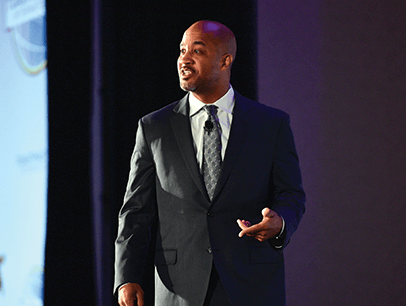
If I put a trophy on top of a table, what do you think I want you to focus on, the trophy or the table? It’s the trophy. Why is the table there? It’s there to set up the trophy.
We can look at using narration and dialogue in our speeches in much the same way. Narration is the table; dialogue is the trophy. Narration sets up the dialogue, which is what your audiences really want to hear and see.
Let’s look at how these two tactics can spice up your stories and greatly improve your audience connection.
Dialogue is the heart of any story because it automatically places the audience in your scene, allows them to hear what you heard, and lets them see a character’s reaction to conversations.
Too Much or Too Little?
Many speakers use far too much narration. For example: My wife came home and told me she wanted to go to the circus.
Too much narration can cause your speech to come across like a news report, and we don’t want that. It feels like you are detailing something from the past rather than reliving it in the present.
Relying more on dialogue, the phrase might be: My wife said, “I want to go to the circus.”
That’s more powerful because we hear how the words were spoken. However, if overused, dialogue can cause a speech to come across like a stage play, and we don’t want that either.
What’s the solution? The key is to use an effective mix of narration and dialogue so that your audience knows three important pieces of information:
- Who is talking?
- What is being said?
- How is it being said?
An effective mix might sound like this: My wife came home, ran right up to me, and said, “I want to go to the circus!”
Do you see here how narration and dialogue work together? The narration (table) sets up the dialogue (trophy). What audience members end up remembering, though, is the dialogue, and that’s exactly what we
want as storytellers. Dialogue lets my audience hear
the excitement in my wife’s voice, and it puts them in the scene.
Change Your Style
Many speakers restrict themselves to just using dialogue between characters. However, you can make a much greater connection with your audience, keep them laughing, and stir their emotions when you use these three additional types of dialogue:
1 Character-to-Character Dialogue
This conversational style is the most commonly used type of dialogue. For example, here’s an exchange from one of my stories:
He said, “You can win the World Championship of Public Speaking.” I said, “What are you talking about? I just lost the Humorous Speech Contest at the club level.” He said, “That’s okay. The only thing wrong with your humorous speech was that it wasn’t funny.”
2 Inner Dialogue
Speakers often miss the opportunity to use this style. Inner dialogue involves verbalizing your thoughts so your audience members can literally hear what you were saying to yourself at certain times in your story. For example, in one of my stories, I am about to introduce my speaking hero so he can take the stage. While I was backstage, getting my thoughts together, I actually bumped into him, and this is what happened:
I said, “I’m so excited to introduce you today! You are the man who made me want to get into this business in the first place. Thank you so much for being here.” He didn’t say anything. He just looked at me as if to say, “You don’t belong on the same stage.”
I immediately thought, Well, he’s about to get an introduction he does not expect.
Inner dialogue shows the audience exactly what’s going on inside my mind at that moment. The great news for you as a speaker is, if you thought it then, you can say it now. You just need to use an appropriate stem, a phrase that sets up the dialogue to follow.
Take these three stems: I thought; I was thinking; I’m thinking. Whatever words come next represent inner dialogue.
For example: “I was thinking, I hope the readers of my article understand what I’m saying.”
I hear many speakers use this unnecessary phrase: “I thought to myself …” We don’t need the “to myself” part because who else are you going to think to?
Inner dialogue is important because your audience members can’t get any closer to you than being inside your own mind. Well, that is, unless you get inside of theirs, which is what this final type of dialogue allows you to do.
3 Projected Dialogue
This is by far my favorite type of dialogue because it gives you tremendous freedom as a speaker to share your interpretation of your experiences while still keeping your story completely true. Projected dialogue is when you give dialogue to other characters in your story based on how they are looking at you.
Consider these phrases for projected dialogue:
They looked at me as if they wanted to say, “…”
You’re looking at me as if to say, “…”
Did you notice that the last phrase has to do with your audience? Not only can you project dialogue onto characters in your story, but you can also project it onto your audience. All you need to project is what your audience is likely thinking at a certain moment. For example, I do an activity in which I ask my audience to change 12 things about their own appearance. They give me strange looks and I know what many of them are thinking.
At that moment, I say, “You’re looking at me as if to say, ‘Craig, I don’t even have 12 things on.’” Two fantastic things can happen. Your audience often laughs, and you connect more deeply with them. The audience now feels like you know what they are thinking.
When they get to hear what you think (inner dialogue), and they feel like you know what they’re thinking (projected dialogue) your connection will be nearly unbreakable.
Lift the Trophy
Using a healthy mix of narration and dialogue will indeed infuse life into your stories and speeches. Try putting these three types of dialogue to work for you and open many more opportunities to make your audiences TALL (think, act, laugh, learn).
Hopefully, you’re reading this and thinking, Great! I’m going to try these tools out!
Want more tips for your next presentation? Watch Craig Valentine take the stage at the 2019 Toastmasters International Convention, where he shares the top tools you need to present with impact, motivate your audience, and build a message that sticks.
Craig Valentine is the 1999 World Champion of Public Speaking. He is an internationally known professional speaker, author, and speech coach and is the founder of the Speak and Prosper Academy. Learn more at www.52speakingtips.com.
Related Articles

Communication
Using Stories to Breathe Life into Every Speech

Presentation Skills



 Previous
Previous

 Previous Article
Previous Article